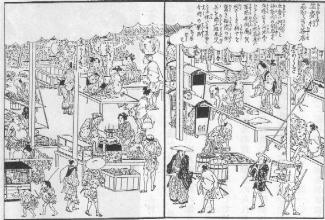- Yokohama-shi Top Page
- Tsurumi Ward Top Page
- Introduction of the ward
- Overview of Tsurumi Ward
- History of Tsurumi Ward
- 19th: Daisen religion and pilgrimage memorial tower
Here's the text.
19th: Daisen religion and pilgrimage memorial tower
Last Updated July 9, 2024
Afuri of Oyama Afurijinja is said to be derived from "falling". It is said that when Oyama is wrapped in fog or clouds, it rains. It may have been named after the experiences of the villagers who have lived a long history while looking at Oyama.
Oyama Afurijinja Engi made its establishment before the Shoo era (1288-1292), and five colors of colored light emitted from the summit of Oyama, illuminated Awa, Kazusa, and Sagami, and Oyama became a prayer temple by Ryoben. It is said that the tax of Boso Mikuni was applied.
On August 9, 1192, the history book of the Kamakura period, Azuma Kagami, 27 temples in Sagami were selected for the birth of Masako Hojo (born in the morning). It is known that Taisanji was among them, and that it was already one of the leading temples at the time. In the early modern era, Oyama, which was close to Edo, gathered its religion as a sacred mountain, and was also busy as a course for visiting famous places around Enoshima Kamakura.

Tsurumi Village Shiga Raki Chaya
The Tokaido Famous Zoukai depicts the prosperity of Tsurumi's position Chaya Shigaraki, and says, "Shigaraki Chaya Toheru Suichaya opens a shop during the Kyoho period, shredded plums, and sold plum pickled red ginger. People who come and go have no rest here, and do not lick the prosperity of this time. "
The festival of Oyama Ishison was held every year from July 27 to August 17 in the lunar calendar, and was the busiest time of the teahouse on the highway. During the Ansei era (1854-59), Edo poet Tsukimoto, who rested at Shigaraki Chaya, wrote an excellent phrase, "The eaves of the teahouses that imitate autumn breeze and what." Maneki is a sign during a lecture on the eaves of a teahouse. In the Edo period, along with Oyama and Mount Fuji, a pilgrimage to Kannon Sacred Grounds in various places flourished. Visiting the Hyaku Kannon Fudasho, which includes the West, Bando, Chichibu, etc., is also popular, and when returning to Japan after the pilgrimage, a commemorative pilgrimage memorial tower has been built in appreciation of the Shinto and Buddha.
People on the pilgrimage to the West, in addition to the Sekisho bill, felt anxious about the severe trip of the pilgrimage, and carried a letter stating, "I'm sorry for the delivery of the pilgrimage." He refused that even if he died during the pilgrimage, he would not inform Kunimoto. In such a case, the villages of the destination would have had arrangements for the treatment in advance.
There is a pilgrimage memorial tower of Tenmeiroku (1786) at Jizo-do on the former Oyama Road at Uemiya 1-chome. In the past, the people who visited Oyama on this highway would have come in front of Jizo at this Tsuji, praying for the safety of their journey, and passing by. Beside Jizo-do, there is a signpost of "Oyama Sando Road Safety Tsujiji Toshi Prayer Tower".
From Tsurusho, Tsurumi Ward Cultural Association
Tsurumi History Society / Tsukasa Okuma
Inquiries to this page
Tsurumi Ward General Affairs Department Ward Administration Promotion Division
Telephone: 045-510-1680
Telephone: 045-510-1680
Fax: 045-510-1891
Email address: tr-kusei@city.yokohama.lg.jp
Page ID: 828-694-373













